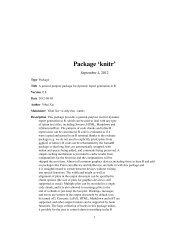Package 'openair'
Package 'openair'
Package 'openair'
You also want an ePaper? Increase the reach of your titles
YUMPU automatically turns print PDFs into web optimized ePapers that Google loves.
112 summaryPlotpollutantperiodbreakscol.trendcol.datacol.miscol.histcolsdate.breaksauto.textpollutant is used when there is a field site and there is more than one site inthe data frame.period is either year (the default) or month. Statistics are calculated dependingon the period chosen.Number of histogram bins. Sometime useful but not easy to set a single valuefor a range of very different variables.Colour to be used to show the monthly trend of the data, shown as a shadedregion. Type colors() into R to see the full range of colour names.Colour to be used to show the presence of data. Type colors() into R to seethe full range of colour names.Colour to be used to show missing data.Colour for the histogram or density plot.Predefined colour scheme, currently only enabled for "greyscale".Number of major x-axis intervals to use. The function will try and choose a sensiblenumber of dates/times as well as formatting the date/time appropriately tothe range being considered. This does not always work as desired automatically.The user can therefore increase or decrease the number of intervals by adjustingthe value of date.breaks up or down.Either TRUE (default) or FALSE. If TRUE titles and axis labels will automaticallytry and format pollutant names and units properly e.g. by subscripting the ‘2’ inNO2.... Other graphical parameters. Commonly used examples include the axis and titlelabelling options (such as xlab, ylab and main), which are all passed tothe plot via quickText to handle routine formatting. As summaryPlot has twocomponents, the axis labels may be a vector. For example, the default case(type = "histogram") sets y labels equivalent to ylab = c("", "Percent ofTotal").DetailssummaryPlot produces two panels of plots: one showing the presence/absence of data and theother the distributions. The left panel shows time series and codes the presence or absence of datain different colours. By stacking the plots one on top of another it is easy to compare differentpollutants/variables. Overall statistics are given for each variable: mean, maximum, minimum,missing hours (also expressed as a percentage), median and the 95th percentile. For each year thedata capture rate (expressed as a percentage of hours in that year) is also given.The right panel shows either a histogram or a density plot depending on the choice of type. Densityplots avoid the issue of arbitrary bin sizes that can sometimes provide a misleading view of the datadistribution. Density plots are often more appropriate, but their effectiveness will depend on thedata in question.summaryPlot will only show data that are numeric or integer type. This is useful for checkingthat data have been imported properly. For example, if for some reason a column representingwind speed erroneosly had one or more fields with charcters in, the whole column would be eithercharacter or factor type. The absence of a wind speed variable in the summaryPlot plot would
















